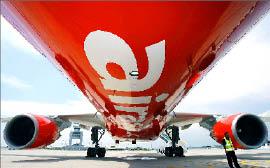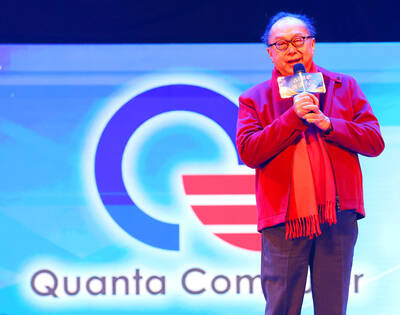Multibillion-dollar orders for more than 100 new planes this week underscored the difference between the thriving budget airline sector in Asia-Pacific and the gloom-hit global aviation industry.
India’s GoAir and Cebu Pacific of the Philippines on Thursday said they had each signed deals with European planemaker Airbus that would see them massively boost their fleets.
“A low-cost carrier boom is undoubtedly taking place in Asia-Pacific,” said Daniel Tsang, chief analyst of Hong Kong-based aviation consultancy Aspire Aviation.

Photo: AFP
“Low cost carriers could easily capture up to half of air travel within the next 20 years or so, which is, quite frankly, a conservative figure,” Tsang said.
The International Air Transport Association, which represents 230 carriers that account for more than 90 percent of worldwide scheduled air traffic, but excludes many budget operations, has halved its profit forecast for the world airline industry this year to US$4 billion.
The figure, which would represent a 78 percent fall on profits last year, reflects the challenges posed to the industry by the March tsunami in Japan, unrest in the Middle East and North Africa and high oil prices.
However, Asia-Pacific budget carriers appear unfazed and have continued to ramp up their service.
GoAir said it had placed an order for 72 new A320 Airbus aircraft in a deal worth up to US$7.2 billion at list prices, while Cebu Pacific announced it had ordered 37 new Airbus jets worth an estimated US$3.8 billion.
Industry players expect Malaysia’s AirAsia, which sparked the growth of budget travel in the region, to ink a new deal with Airbus for up to 200 aircraft at this week’s Paris Air Show.
US plane maker Boeing on Thursday hiked its 20-year forecast for the size of the global commercial aircraft market by 8 percent to 33,500 planes worth US$4 trillion, with the Asia-Pacific region accounting for a third of sales.
AirAsia chief Tony Fernandes said last month that he may boost the firm’s Airbus fleet five-fold to 500 as more people in the region demand cheaper flights.
“We have 600 million people just in ASEAN,” he said.
India and China, which are already served by budget carriers from ASEAN cities, have a -combined population of 2.5 billion.
Rapid economic growth in ASEAN, China and India, coupled with falling air fares means millions more can now fly rather than travel by land or sea compared to the pre-budget airline era.
“The exponential growth for low-cost carriers in Asia-Pacific is supported by emerging economies and their citizens’ soaring income,” Tsang said.
The European and US markets, by contrast, are facing “sluggish economic recoveries and cautious consumers,” he added.
The boom in budget travel has prompted more established airlines to explore the no-frills market as well.
Singapore Airlines, a leader in premium travel, announced last month that it will launch within one year a no-frills brand that will fly on medium to long-haul destinations — an indication it could fly as far as Europe.
AirAsia’s long-haul arm, AirAsia X, already flies to 15 destinations, including Taipei, London, Tehran, Paris, Seoul, Tokyo, Christchurch in New Zealand and several cities in Australia, China and India.
Brendan Sobie, Southeast Asia specialist at aviation intelligence firm Centre for Asia Pacific Aviation, said established names like Singapore Airlines have realized they can no longer bank on their current clients for growth.
“As low-cost carriers continue to grow more rapidly than full service carriers, we expect low-cost carriers to continue growing their share of the market by roughly two percentage points per annum,” he said.
It’s not only the Asian middle class that benefits from the boom in low-cost carriers, which are able to slash fares by cutting out in-flight entertainment, using cheaper airports and charging for food and amenities.
Filipino domestic worker Nida Jumawan, 49, said she had no wish to return to the old days when ferries were the only affordable means of transport between the Philippines’ far-flung islands.
She said the plane fare from Manila to her hometown of Pagadian in the southern Philippines, could drop to as low as 800 pesos (US$18.35) compared with the ferry fee of about 3,000 pesos.
“Flying is much easier compared to ferries. It is terrifying at sea when you are caught up in a typhoon — you can’t sleep, you get dizzy and you throw up,” Jumawan said.

Intel Corp chief executive officer Lip-Bu Tan (陳立武) is expected to meet with Taiwanese suppliers next month in conjunction with the opening of the Computex Taipei trade show, supply chain sources said on Monday. The visit, the first for Tan to Taiwan since assuming his new post last month, would be aimed at enhancing Intel’s ties with suppliers in Taiwan as he attempts to help turn around the struggling US chipmaker, the sources said. Tan is to hold a banquet to celebrate Intel’s 40-year presence in Taiwan before Computex opens on May 20 and invite dozens of Taiwanese suppliers to exchange views

Application-specific integrated circuit designer Faraday Technology Corp (智原) yesterday said that although revenue this quarter would decline 30 percent from last quarter, it retained its full-year forecast of revenue growth of 100 percent. The company attributed the quarterly drop to a slowdown in customers’ production of chips using Faraday’s advanced packaging technology. The company is still confident about its revenue growth this year, given its strong “design-win” — or the projects it won to help customers design their chips, Faraday president Steve Wang (王國雍) told an online earnings conference. “The design-win this year is better than we expected. We believe we will win

Quanta Computer Inc (廣達) chairman Barry Lam (林百里) is expected to share his views about the artificial intelligence (AI) industry’s prospects during his speech at the company’s 37th anniversary ceremony, as AI servers have become a new growth engine for the equipment manufacturing service provider. Lam’s speech is much anticipated, as Quanta has risen as one of the world’s major AI server suppliers. The company reported a 30 percent year-on-year growth in consolidated revenue to NT$1.41 trillion (US$43.35 billion) last year, thanks to fast-growing demand for servers, especially those with AI capabilities. The company told investors in November last year that

Power supply and electronic components maker Delta Electronics Inc (台達電) yesterday said it plans to ship its new 1 megawatt charging systems for electric trucks and buses in the first half of next year at the earliest. The new charging piles, which deliver up to 1 megawatt of charging power, are designed for heavy-duty electric vehicles, and support a maximum current of 1,500 amperes and output of 1,250 volts, Delta said in a news release. “If everything goes smoothly, we could begin shipping those new charging systems as early as in the first half of next year,” a company official said. The new